 |
| Home Intro Technical History Crew Models Gallery Kriegsmarine Archives More Forum Español |
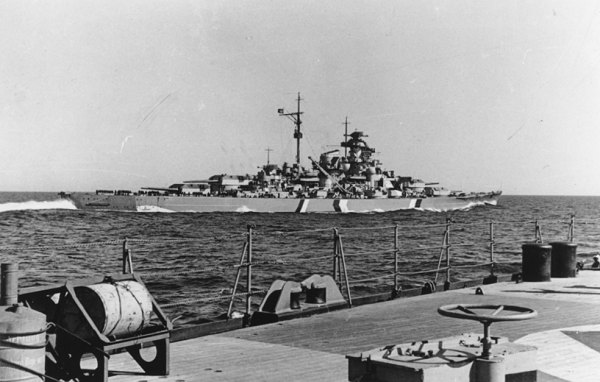
Immediately after the Bismarck was commissioned and the crew organised into divisions, full training began. This included guided tours through the battleship, anti-aircraft watch and combat training in the harbour to get familiar with the ship and to work together as a team. Air alarms, damage control and battle stations were the most common drills.
On 15 September 1940, the Bismarck departed Hamburg for the first time to conduct her sea trials in the Baltic Sea with her base in Gotenhafen (today Gdynia). The Baltic was a very secure place to conduct sea trials and exercises, and it was utilized by practically every single unit in the Kriegsmarine during the war. Its only entrance through the Skagerrak and the Kattegat was very well guarded and strongly protected by minefields. At 1658, while steaming north down the Elbe River, the Bismarck collided with the bow tug Atlantik, but fortunately neither vessel was damaged, and at 1902 the battleship anchored in Brunsbüttel Roads in order to enter the Kiel Canal the next day. During the night of 15/16 September, while anchored there, British aircraft appeared in the sky and the anti-aircraft battery of the Bismarck engaged them at once. More than 300 projectiles were fired by Bismarck, but no observable hits were scored on enemy aircraft.
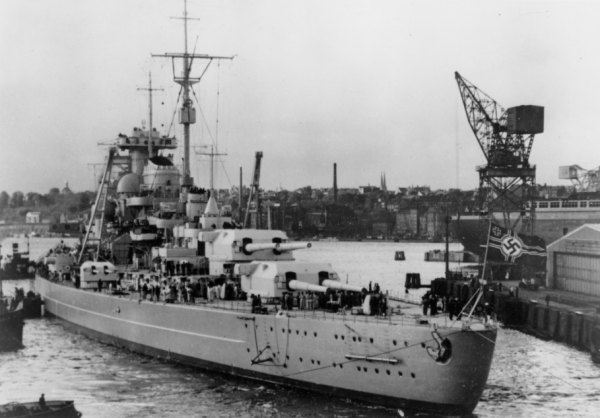
The Bismarck leaving the Blohm & Voss shipyard in Hamburg on 15 September 1940.
On 16 September, the
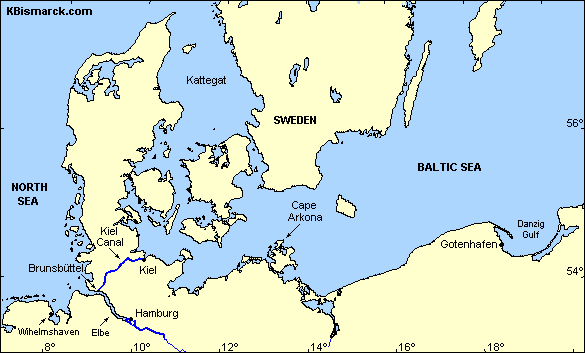
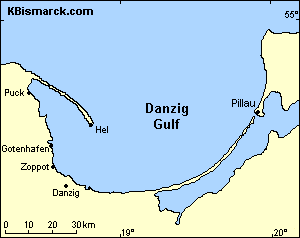 Once in Gotenhafen, and during the following two months, the Bismarck conducted several navigation, consumption, and speed trials in the Gulf of Danzig.
Measured mile runs (Meilenfahrten) were performed in 65-metre deep waters off Neukrug, in the Vistula Spit, not far from Pillau (today Baltiysk).
On 23 October the ship was finally ready to sail at full speed.
The propulsion plant originally designed to reach 138,000 hp and 29 knots actually obtained 150,170 hp and 30.1 knots.
This made of the Bismarck one of the fastest battleships in the world, and clearly faster than any battleship in the Royal Navy.
Sometime in October-November, while at Gotenhafen, the two 10.5-metre stereoscopic base rangefinders were installed above the foretop and aft command posts.
The anti-aircraft battery was still not complete, and the four aft 10.5 cm SK C/33 twin mounts were now installed appropriately in the new C37 model.
In mid-November, the first artillery exercises began, and shortly after the trials were concluded.
At this time, Grand Admiral Raeder visited the Bismarck in Gotenhafen and a few days later, on 5 December, the battleship left the Baltic and returned to Hamburg, where she arrived on the 9th after passing again through the Kiel Canal.
Once in Gotenhafen, and during the following two months, the Bismarck conducted several navigation, consumption, and speed trials in the Gulf of Danzig.
Measured mile runs (Meilenfahrten) were performed in 65-metre deep waters off Neukrug, in the Vistula Spit, not far from Pillau (today Baltiysk).
On 23 October the ship was finally ready to sail at full speed.
The propulsion plant originally designed to reach 138,000 hp and 29 knots actually obtained 150,170 hp and 30.1 knots.
This made of the Bismarck one of the fastest battleships in the world, and clearly faster than any battleship in the Royal Navy.
Sometime in October-November, while at Gotenhafen, the two 10.5-metre stereoscopic base rangefinders were installed above the foretop and aft command posts.
The anti-aircraft battery was still not complete, and the four aft 10.5 cm SK C/33 twin mounts were now installed appropriately in the new C37 model.
In mid-November, the first artillery exercises began, and shortly after the trials were concluded.
At this time, Grand Admiral Raeder visited the Bismarck in Gotenhafen and a few days later, on 5 December, the battleship left the Baltic and returned to Hamburg, where she arrived on the 9th after passing again through the Kiel Canal.
In Hamburg, the battleship was again moored to the Blohm & Voss equipping pier to receive the final adjustments.
The 10.5-metre rangefinder on turret "Anton" was removed because its lack of utility due to sea water fogging at high speeds.
The ship was also painted over with the striped camouflage used by most of the big German ships of that time.
Three angled black and white stripes over the hull and superstructure, with the ship's ends in dark grey and false white waves.
For aerial recognition, the national emblems (swastikas) were painted on the stern deck and breastworks, and dark grey was applied to the top of the main and secondary batteries.
The crews were released on Christmas leave, and for many of them this was to be the last chance to see their relatives.
Korvettenkapitän Adalbert Schneider acted as Bismarck's Deputy Commander in substitution of Captain Lindemann from 16 to 31 December.
On 24 January 1941, the Bismarck was again ready to go back to the Baltic to continue the sea trials, but the Kiel Canal was temporarily blocked by ice and the wreck of a merchant ship.
Since the High Command disapproved the voyage around the Jutland Peninsula, the departure had to be postponed.
Therefore, the battleship remained in Hamburg where there was a much greater anti-aircraft protection than at Brunsbüttel, and combat training in port continued through February until the canal was cleared.1)
Finally, on 6 March the Bismarck departed Hamburg, steamed down the Elbe and anchored in Brunsbüttel Roads at 1224 hours, together with two mine barrage breakers (Sperrbrecher) and one icebreaker as protection against torpedo aircraft.
At 0822 hours on the next day (7th) Bismarck weighed anchor and proceeded into Brunsbüttel locks aided by two bow tugs.
Under the air cover of two Me-109 fighters she passed once again through the Kiel Canal.
At 0845 hours on 8 March, while approaching the Kiel-Holtenau sluice, Bismarck ran aground on the south side of the canal and had to be assisted by a tug, but she freed herself under her own engine power.
Nevertheless, due to this incident, the Bismarck went directly to Deutsche Werke in Kiel where she entered the 40,000-ton floating Dock C shortly before noon.
In the following days, work on the under water hull and bottom painting was carried out.
During the course of a British air raid over Kiel, at 0405 hours on 12 March the floating dock was lowered deeper into the water by 6 metres as a measure of protection.
On board the Bismarck, however, a bottom valve was accidentally left open and the starboard auxiliary boiler machinery room in section XII was flooded.
It took only 12 minutes to pump the water out.
On 14 March, the Bismarck was undocked and then towed by tug to Scheerhafen, where she was moored to the North Mole.
There, the batteries were calibrated again, and the battleship loaded with provisions, ammunition, fuel, and water.
At this time, the 7-metre base rangefinder was attached to the forward conning tower.
On 15 March, two Arado Ar 196 aircraft (T3+IH and T3+AK) were embarked; these were the first two aircraft of a complete air wing of four that would arrive at a later date.
Two days later, on 17 March, the Bismarck left Kiel escorted by the old pre-dreadnought battleship Schlesien and the mine barrage breaker 36, and together they steamed east to Gotenhafen.
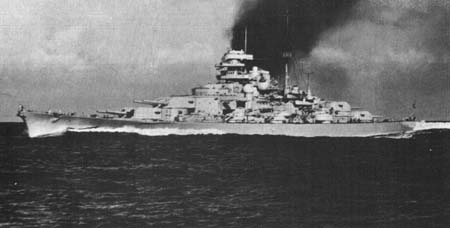
The Bismarck steaming at high speed in the Baltic Sea. October 1940.
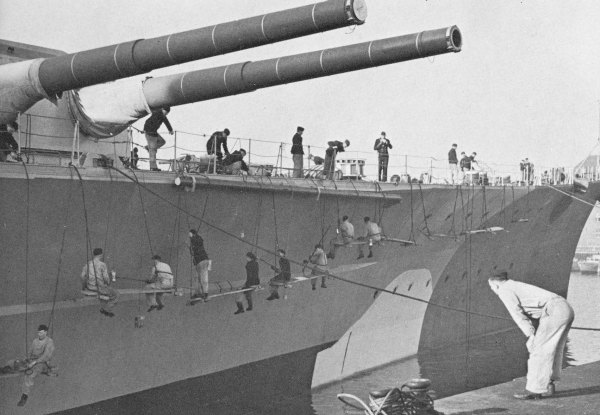
Crewmen applying a coat of paint to the hull. Note the false white wave. This was intended to confuse enemy observers and make them believe that the ship was steaming at high speed. Scheerhafen, Kiel 14-16 March 1941.
Footnotes:
1) During that layover the Artillery Testing Command for Ships (AVKS) came aboard for an intensive inspection of gunnery and rangefinder equipment, that lasted from 29 January to 2 April 1941. A number of deficiencies that needed to be fixed were later reported but overall big faliures did not occur (see AVKS report No. 700).

Home Guestbook Quiz Glossary Help us Weights & Measures Video Credits Links Contact
